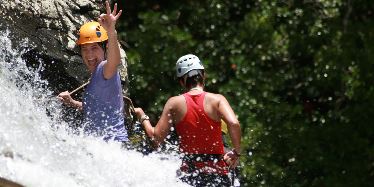Adventurous Journey

The Adventurous Journey section of The Duke of Ed encourages you to explore the outdoors, gain a sense of adventure and learn about the environment.
Choose your adventure
You can choose from 3 types of Adventurous Journeys:
Expedition
- What: The main focus is on the journey—outdoor activities that require you to find a safe route, navigate, pitch tents and set up a camp, or even bicycle maintenance on a cycling trip.
- Where: The journey can be over land, in the air or on waterways.
- Who: Bronze, Silver or Gold participants; you must go in a group.
- Activity ideas: bushwalking, canoeing, cross country skiing, cycling, horse riding, rafting, climbing or sailing.
Exploration
- What: The main focus is on the purpose of the journey—investigating or researching and collecting information.
- Where: It can be in an urban or outdoor setting.
- Who: Bronze, Silver or Gold participants; you must go in a group.
- Activity ideas: cultural or historical trips (e.g. visits to museums or cultural sites), scientific exploration, marine study, survey of a national park or wildlife park, rock climbing, or snorkelling.
Adventurous Project
- What: A journey that is not quite an expedition or exploration. It tends to require more innovation, creativity and challenge than an expedition or exploration, and can be done solo.
- Where: It can be in an urban or outdoor setting.
- Who: Gold participants who are 18 years or older only; you do not need to be in a group. You need approval from the Queensland Award Operating Authority to do an Adventurous Project.
- Activity ideas: set out on a solo sailing trip, climb a mountain, follow an ancient pilgrimage (in Australia or overseas), retrace the path of an early explorer, or study ecosystems in a remote area.
Requirements
Before you start
- Discuss your plans with your Award Leader and get their approval to proceed. Gold participants will also need to submit an Gold Award Plan (PDF, 445KB) or (RTF, 179KB) to the Queensland Award Operating Authority for approval.
- Provide your Award Coordinator with a P4 Adventurous Journey consent form (PDF, 577KB) or (RTF, 148KB).
- Organise a group to do the journey with you—for safety reasons, a minimum of 4 people must participate (unless you have been approved to do a solo Adventurous Project). Up to 7 people can be in a group; groups larger than 7 can be split into smaller sub-groups.
- Make sure you have an Adventurous Journey Supervisor for your journey if you are under 18—including for the preparation, training, practice journey and qualifying journey.
- Organise emergency equipment if your journey is in a remote area.
- Do at least 1 practice journey, similar to your qualifying journey but over a different route.
Adult supervision
All Adventurous Journeys involving participants under 18 years need a qualified Adventurous Journey Supervisor for all activities under this section—this includes the preparation, training, practice journey and qualifying journey.
Participants over 18 doing an Adventurous Project will need an Adventurous Journey Supervisor to approve their journey, and may decide to have one to turn to for guidance and support.
If your journey involves an outdoor medium—such as canoeing or hiking through the bush—then your Adventurous Journey Supervisor will need a nationally recognised qualification in the outdoor medium you will be taking.
If your journey is in an urban setting (e.g. taking a bus to a museum) then your Adventurous Journey Supervisor does not need an outdoor qualification.
Emergency equipment
Emergency equipment is required for all Adventurous Journeys in remote areas where professional medical care is more than 1 hour away.
Equipment must include:
- an emergency positioning device such as a Personal Locator Beacon (PLB)
- appropriate two-way communication equipment such as a mobile phone, satellite phone, or handheld UHF radios.
Recording your journey
You must keep and submit a record of your journey. This can be a written log book, scrapbook, photographic record, audio or video log, or any combination of these.
Your log may include things such as a description of the journey, map, route plan, equipment, food and clothing lists, drawings, photos and any personal reflections you had during and after the journey.
Time commitment
You need to do 1 qualifying journey and at least 1 practice journey using the same mode of travel and for the same length of time.
The length of each of your qualifying and practice journeys needs to be:
- Bronze level—2 days and 1 night with at least 6 hours of activity each day
- Silver level—3 days and 2 nights with at least 7 hours of activity each day
- Gold level—4 days and 3 nights with at least 8 hours of activity each day.
You will also need to allow time to train and prepare for your journeys.
Support materials
You may find the below documents useful when it comes to completing your journey. You can request any of these by emailing qld.award.office@qed.qld.gov.au:
- Adventurous Journey fact sheet
- P1 Adventurous Journey participant plan
- P2 Adventurous Journey navigation data table
- P3 Adventurous Journey medical consent form.
Related links
- Award levels
- Adventurous Journey forms for Award Centres and adult volunteers
- Completing The Duke of Ed


